Yachting Monthly
- Digital edition


Nicholson 32: an ocean-going pedigree that lasts
- Duncan Kent
- March 8, 2021
Built entirely out of GRP, the Nicholson 32’s ocean-going pedigree remains desirable to this day, says Duncan Kent

A long keel and heavy displacement makes the Nicholson 32 ideal for coastal and offshore cruising. Credit: Genevieve Leaper
Product Overview
Manufacturer:.
The primary design considerations for the Nicholson 32 were to produce an easily handled yacht of moderate dimensions, capable of a sea-kindly sailing performance in all conditions.
She was to have the classic looks of a traditional wooden yacht but was in fact one of the first offshore cruisers to be built entirely out of GRP, to a high specification and enviable build quality.
A little history of the Nicholson 32
The Nicholson 32 was a development of the successful South Coast One Design (SCOD) and other proven Charles Nicholson designs like the nine-tonner, Jolina .
Charles’ son, Peter, believed demand for custom yachts was dwindling and glass-fibre production yachts were the future.
The Nicholson 32 had to meet three criteria.
It had to be about 32ft (9.7m) long, easy to build and cost less than £5,000 at the time.
The hulls were moulded by Halmatic in Portsmouth and mainly fitted out by Camper & Nicholson.
For maximum strength and integrity, the hull, deck, ballast, bulkheads and furniture were all bonded together.
Most have suffered from osmosis over the years and many will have been peeled, dried and re-gelled.

The Nicholson 32 was one of the first yachts designed for GRP production. Credit: Simon Braunholtz
Make sure the cost of any osmosis remedial work is reflected in the price.
The marque went through 11 model upgrades, including some quite major redesigns.
The 1963 Mk I models (1-6) had mahogany joinery and individually built furniture.
A few changes were made for the Mk II (7-10), most importantly aluminium spars.
A good many more additions were made to the Mk III (11-40) and the Mk IV yachts (41-87), including a cockpit sole engine hatch, U-bolt chainplates, aluminium framed windows and a teak interior.
By 1966, the Mk V boat (88-111) was in production with numerous enhancements to the engine compartment and a stainless-steel fuel tank.
Further refurbishments to the interior, including replacing the pilot berth with a pull-out double, denoted the Mk VI (112-147) and Mk VII (148-190) yachts, while the Mk VIII (191-236) models had new windows and hatches.
There was no Mk IX but the Mk X (237-329) underwent major modernisation and restyling.
The freeboard was raised 3in/75mm, enabling the coachroof to be lowered and the windows redesigned.
Her cockpit was enlarged by removing the afterdeck, increasing her length to 10m/33ft, and the offset companionway was moved to the centreline.
Myriad other modifications were incorporated, including new scuppers, bow roller, locker drains and handrails, a better 12-volt electrical system and the interior was again updated.
In 1977, Halmatic built another 40 Mk XI models, after modifications to make it cheaper to build.
They introduced GRP furniture modules, a restyled galley, a quarterberth behind a forward-facing chart table and optional wheel steering.
Down below on the Nicholson 32
Early models had a basic layout.
The positioning of the water and fuel tanks above the keel left plenty of stowage beneath the bunks.
She had comfortable twin berths in the forepeak and two 1.93m/6ft 4in straight settees in the saloon, plus a pilot berth above the port settee.
From the Mk IV the latter was removed and replaced by a double, formed by sliding a board out from under the settee.
It wasn’t until the Mk X model that she gained a quarterberth.
The heads were forward of the saloon, with a sink opposite.
Sliding both forecabin and saloon doors closed gave privacy and plenty of room for washing.

The galley on older models is basic with a single sink. Credit: Bob Aylott
The original galley was pretty rudimentary, with a non-gimballing Primus stove and a single sink with hand-pumped cold water.
Stowage was reasonable, though, and most will have been upgraded by owners.
Headroom is 1.83m/6ft throughout the saloon/galley area.
The chart table was originally a longitudinal, stand-at affair, but was later (Mk X+) moved to port, turned sideways and used the settee as a seat.
That allowed the galley to be enlarged to take a gimballed cooker. On deck Her cockpit is roomy and high coamings keep the spray out and crew in.
Stepping out onto the side decks is safe as they are wide and uncluttered.
The coachroof-mounted handrails are well within reach as far as the shrouds and her raised, teak-capped gunwales provide good foot bracing.
There were originally difficulties with moulded-in stanchion sockets, causing the decks to craze if any substantial sideways pressure was put on them.

The MK IV has a teak interior. Credit: Bob Aylott
Separate metal bases were used in later models.
The foredeck is roomy thanks to her broad shoulders and pre-1972 models have a moulded recess to accommodate a Danforth anchor.
This intruded into the forecabin quite noticeably, along with the chain pipe taking the rode down to a chain locker beneath the bunk.
The recess was finally removed in the Mk XI and replaced with a self-stowing, stemhead anchor roller for a CQR.
Her running rigging is simple, with long genoa tracks atop the bulwarks leading to large primary winches aside the helm.
Pre-Mk X models had the mainsheet track along the afterdeck, which was later moved to just abaft the rudder stock.
Rig & sails
All models were masthead rigged with a relatively short mast and a full set of stout shrouds.
Silver anodised masts from Proctors were installed from the Mk II model onwards and had a single set of straight spreaders.

Every model is masthead rigged. Credit: Genevieve Leaper
She came with several hanked-on headsails at first, but a furling genoa was later provided as standard instead.
Some had an optional inner forestay (often removeable) for rigging a storm jib.
Her well-balanced seakeeping qualities and comfortable motion were accomplished by giving her a heavy displacement, long overhangs, a full keel and a 50% ballast ratio.
A 24ft waterline, broad shoulders and high wetted surface area means she isn’t particularly quick in modern terms, especially in light airs, but that said she is stiff, stands up well to full sail, is relatively light on the helm and exhibits very little leeway.
Her bluff bows and relatively broad shoulders can make her baulk sailing close-hauled in heavy seas, but usually freeing her off a few degrees cures the problem.

The stepped coachroof on the Mk IV gives extra headroom. Credit: Bob Aylott
Her buoyant bow sections can produce a tendency to yaw downwind, so many advise adding some ballast up forward.
The combination of her short mast, hefty lead ballast, full keel and buoyant hull means she rarely heels beyond a comfortable ‘lean’.
Her barn door-style rudder can induce a little weather helm when pushed, but in mitigation the rudder never loses its bite, meaning she’s unlikely to broach in big seas.
Under power
Originally a 29hp diesel Watermota Sea Panther provided the power.
Like all long-keelers the Nicholson 32 was awful going astern under power.
The trick was to build up a little speed some way off where you wanted to end up and then knock it out of gear using the speed through the water to steer.
Too much speed, though, and the tiller would be ripped out of your hands!
Owners’ experiences
S/Y Fals Cappa (Mk VII, HN 171, LD 1969)
Alan Thorne, 63, has owned the five berth Mk VII model for 10 years and says she’s a delight to sail.
Under his ownership he has carried out numerous improvements, including upgrading the headsail winches to self-tailing, adding spinnaker winches and Aries wind vane steering, plus many of the usual upgrades to modernise the electronics.
He has also removed the furling headsail in favour of hank-on sails.

Fals Cappa has hank-on sails. Credit: Alan Thorne
Fals Cappa had already had her engine replaced when he purchased her.
‘I have found no faults in the design or construction,’ he notes.
Now widowed, he sails singlehanded along the East and South Coast, as well as to France, Belgium and Holland.
Asked how she sails, Alan says: ‘Wonderful! She sails like a dinghy, beautifully balanced, secure and reassuring in all sea conditions that I’ve encountered. Cuts through waves while other yachts are slamming or rounding up.
‘With an autopilot and wind vane a Nicholson 32 is a delight to sail single-handed. During the past couple of years, I have raced her single-handed too and thoroughly enjoyed it, although changing hank-on headsails mid-race is a tad exciting on short legs!’
S/Y Ballyhoo (Mk VIII, HN 203, LD 1970)
Sandy, 76 and Josephine, 72 Tyndale-Biscoe have owned Ballyhoo since 1999, and now keep her in Falmouth.
The couple both learned to sail dinghies as children.
Sandy also sailed the RNE Manadon college’s Morgan Giles 43 yachts when he was in the Royal Navy.
‘We were given an Albacore after we married, but found that small children and large, high-performance dinghies do not really mix. So, after some years canalling in a narrowboat, we bought Vin Rosé , a British Folkboat with a doghouse,’ says Sandy.
The couple have also owned a Fisher 25 Freeward before buying Ballyhoo at the Lymington Used Boat Show.

The Nicholson 32 had 11 model upgrades. Credit: Sandy & Josephine Tyndale-Biscoe
‘She is, I think, unique in having a deck-stepped mast. We replaced her engine with a 24hp Beta Marine in 2014. Otherwise,’ Sandy says, ‘she is original. We have found no faults beyond the usual wear and tear common in any boat of her age.
‘ Ballyhoo has plenty of sail for the conditions where we sail. I generally use the Nº1 jib and take a reef above 12kts true wind. Once, during a Channel crossing in a westerly Force 6, the jib furler jammed, so we dropped the main and proceeded under genoa alone.
‘Unable to cross the Chichester Bar for three hours forced us to beat up the Solent for shelter. Discovering that Ballyhoo would sail to windward under genoa alone in such conditions gave us enormous confidence. I like the security of knowing that she is able to stand up to practically anything the weather can throw at her.’
S/Y Hy-Brasail (Mk IV, HN 85, LD 1965)
Simon Braunholtz, 62, has owned Hy-Brasail for eight years, in which time he has fitted a removable inner forestay and a diesel heater.
Before crossing the Atlantic, her previous owner led all lines into the cockpit to simplify reefing.
‘When I bought her there were leaky deck fittings and windows, which we fixed. Hy-Brasail has the pilot berth behind the port settee, which Simon says, ‘is an excellent berth for off-watch crew and extremely useful for stowing bags on passage.’
A flexible water tank in the forepeak feeds a foot-pump at the galley and the previous owner fitted a fridge.
She has a wind generator to keep the batteries topped up.’
For several years Simon kept Hy-Brasail in Scotland before moving her to Falmouth and finally Devon.

All lines on Hy-Brasail lead into the cockpit to simplify reefing. Credit: Simon Braunholtz
‘The Nicholson 32 is a lovely boat to sail. Her deep long hull with over three tonnes of lead ballast takes her through seas without bouncing around or slapping the water, although her low freeboard means the toe-rails sometimes get wet. She is comfortable for two, although comfort is a relative term. She was built at a time when people wanted adventure on the water, rather than a chilled Chardonnay tied to a pontoon.
‘The Bukh 24 engine has proven reliable, with regular maintenance. Motoring backwards is “interesting”, but I’ve become accustomed to it.’
Simon also owns a 1970 Mk VIII model, Splashdown (HN 212), moored on the west coast of Scotland.
‘The main difference is she has no pilot berth so the settee is set further back. The additional space makes her more comfortable than Hy-Brasail and the cabin table is larger.
‘She is equipped with radar, AIS, a chartplotter, wind generator and an Aries wind vane, which I have rebuilt. Being previously kept in the Mediterranean, she also has a hatch in the main cabin to improve airflow.’
What the experts say about the Nicholson 32
Nick Vass, Marine Surveyor B,Sc B,Ed HND FRINA MCMS DipMarSur YS

www.omega-yachtservices.co.uk
A proper-looking yacht with more freeboard (and therefore dryer) than other Folkboat-inspired yachts such as the Contessa 32 and Twister.
A handsome boat with grown up gunwales and a proper long keel.
Joinery was made to a very high standard and these up-market yachts were equipped with good quality seacocks and deck furniture.
The Nicholson 32 enjoyed a very long production run and evolved through many models and updates.
The defect that I discover most frequently on them is osmosis.
Full-blown, proper inter-laminate osmosis and not the ‘almost osmosis’ that you find between the laminate and layers of gelcoat on a Westerly, for instance. I commonly find osmosis with other Halmatic boats, such as Nelson motor cruisers and pilot boats.
It could be that Halmatic used the same resins as Westerly at the time, which also suffer.
Continues below…

Contessa 32: A brand new classic
Theo Stocker visits the Jeremy Rogers yard to see the latest Contessa 32 take shape

USED BOAT: Nicholson 35
Designed in the late 1960s by Peter Nicholson, the Nicholson 35 quickly earned a reputation as a steadfast ocean cruising…
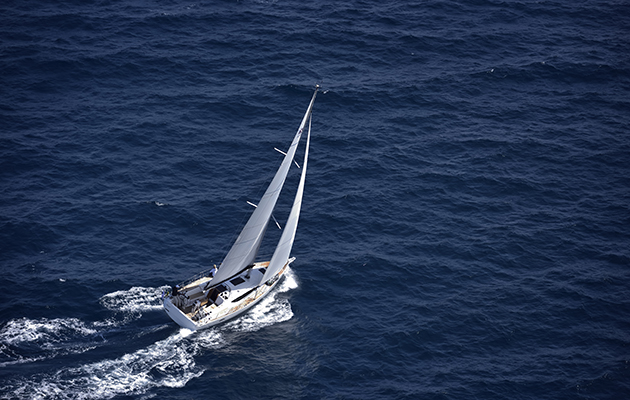
Offshore sailing skills: All you need to know
Will Bruton finds out what coastal cruisers should consider before taking their small yacht on an offshore adventure

Rustler 33 – Yachting Monthly review
She’s an absolute stunner, but does she sail as well as she looks? And what’s it like to spend the…
Another theory is that, whilst obsessed with attaining and keeping Lloyds A1 Scantling Certification, Halmatic tended to over-consolidate the resins into the chopped strand glass-fibre matting and cloth, leaving them a little dry.
Saying that, just about all Nicholsons and Halmatic yachts that have suffered from blistering will have been treated by now.
If buying one, look out for blistering as epoxy treatment only tends to last around 10 years.
The last Nicholson 32 I surveyed still had its original Watermota Sea Panther 30hp engine.
It wouldn’t start so the broker called a young marine engineer to get it going.
He looked at me in disbelief when I told him it was a Ford Consul/Cortina petrol engine with a diesel cylinder head!
He thought that I was messing with him when I further explained that the starter motor was not powerful enough to get a diesel going so there was a special switch to join the batteries in series so they whacked out 24 volts.
Although Watermota engines are actually very good (the company is still making engines in Devon), most of these will have been replaced by now.
Deck joints and stem head fittings have been known to part on some models, but most are likely to have been rectified already.
Ben Sutcliffe-Davies, Marine Surveyor and full member of the Yacht Brokers Designers & Surveyors Association (YDSA)

Ben Sutcliffe- Davies has been in the marine industry for over 40 years as a long- time boat builder, has been surveying craft for over 20 years and is a Full Member of the YDSA.
www.bensutcliffemarine.co.uk
I’ve had the pleasure of surveying many of these well-built yachts.
The issues of moisture are common in all of them although the ones I’ve dealt with haven’t been particularly deep, as most of the boats built by Halmatic had clear resins that generally don’t absorb moisture in the same way as pigmented resin.
As they are predominantly laminated from chop strand, any moisture will be held longer due to the short glass filament strands.
I’ve had no issues with the encapsulated fin keel and ballast incorporated within its lower forward production.
The GRP rudder was hung from the end of her keel moulding and suitably supported.
But I have had a few loose bronze cast shoes, and fastenings should be checked for moisture ingress.
Lastly, be aware that some older boats I’ve surveyed have had a gas locker that drains below the waterline, which will need a rethink.
Enjoyed reading this?
A subscription to Yachting Monthly magazine costs around 40% less than the cover price .
Print and digital editions are available through Magazines Direct – where you can also find the latest deals .
YM is packed with information to help you get the most from your time on the water.
- Take your seamanship to the next level with tips, advice and skills from our experts
- Impartial in-depth reviews of the latest yachts and equipment
- Cruising guides to help you reach those dream destinations
Follow us on Facebook , Twitter and Instagram.
BoatNews.com
My second hand boat / Nicholson 32: a 9.75m sailboat capable of circumnavigating the globe
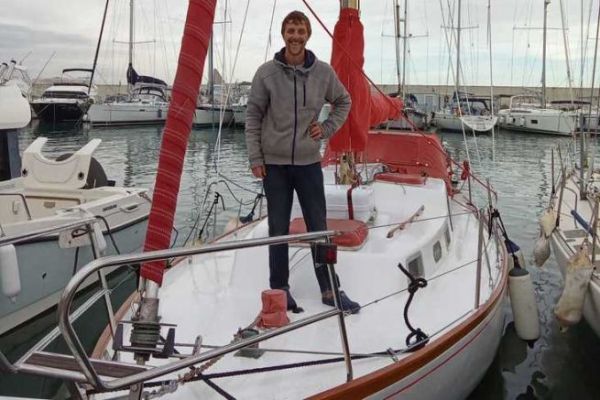
Benoit is the 5th owner of a Nicholson 32, a long-keel sloop with an excellent reputation. He tells us why he chose this yacht, as well as his first impressions.
Benoit, a sailor who wants to sail the open seas

Originally from Martigues , Benoit has been sailing on all kinds of sailboats since his early childhood. For several years now, this liveaboard sailing instructor has owned a Karaté, with which he has completed a number of coastal cruises, as well as the local regatta circuit. But the desire to change boat in anticipation of ocean cruising is on his mind.
" I was looking for a simple, very seaworthy boat within a reasonable budget. What's more, I'm very sensitive to the lines of classic turn-of-the-century sloops. But a wooden hull is too demanding to maintain. After a long search, I settled on the Nicholson 32, which has both classic lines and an excellent reputation for seaworthiness ".
A solid sailboat with several round-the-world voyages under its belt
Built in 370 units, the Nicholson 32 is a long-keel sloop that has sailed the seas of the world. Designed by architect Charles A Nicholson and his son Peter, it was one of the first production boats built in polyester .
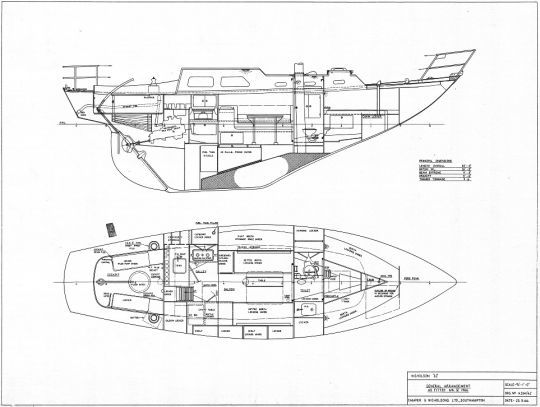
Seaworthy, simple and well-built, it offers excellent handling and satisfactory living space for its time. Several models have sailed non-stop around the world via the southern seas. It was also aboard this yacht that sailor Clare Francis crossed the North Atlantic in 1973.
A well-maintained 1966 model
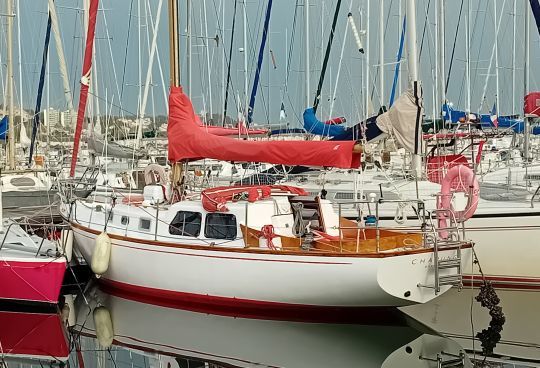
After visiting a first model that didn't inspire him, Benoit came across an ad for a Nicholson 32 based in Spain . The asking price was at the upper end of the range, but this 1966 model was in very good condition.
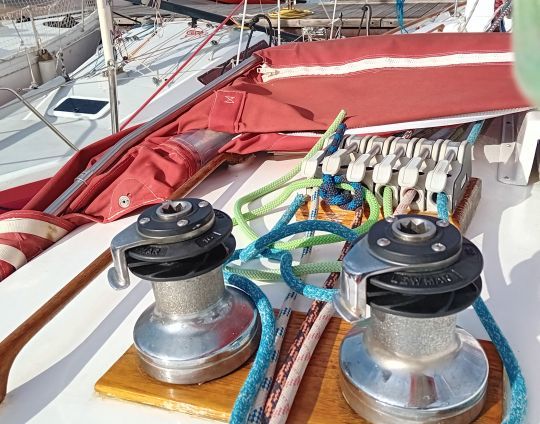
What's more, it has benefited from a number of modifications that have been very well executed. All manoeuvring is back in the cockpit, an opening deck hatch has been installed forward of the coachroof, and a beautiful bow fitting allows the attachment of a stainless steel bowsprit. All the old Goiot winches have been replaced by self-tailings, and the yacht is equipped with a Volvo MD2B, which has been completely overhauled
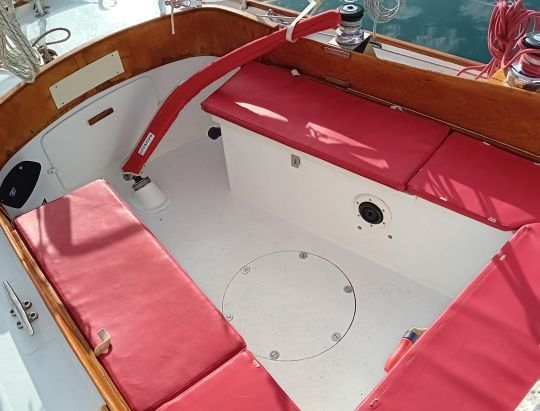
After starting her career in Southampton, this Nicholson 32 sailed to La Rochelle , then Marseille , before arriving in Spain . Her 4 e owner restored her for 5 years. Osmosis treatments were carried out regularly, and the on-board equipment was meticulously maintained.
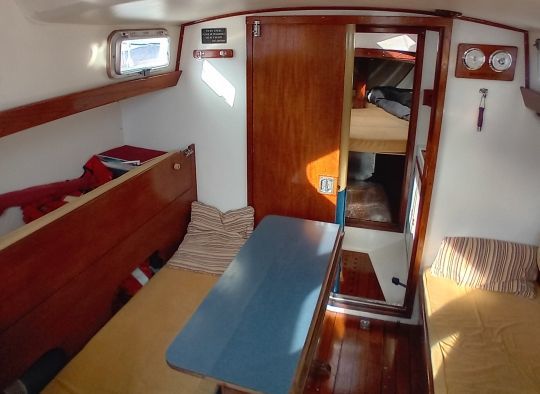
An invigorating grip
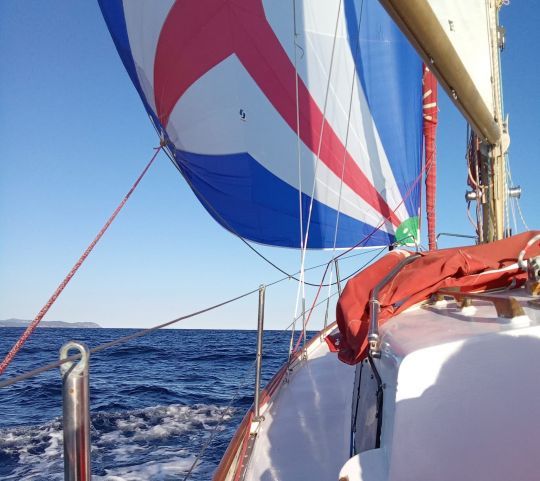
Benoit, accompanied by a crew member, picked up his boat in Segur de Calafell, south of Barcelona. This 240-mile winter delivery trip is an ideal trial run for getting to grips with a new sailboat . After a technical check-up and inventory , the duo cast off for Martigues .
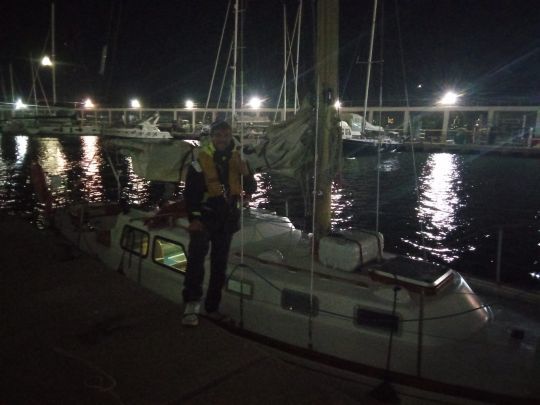
Right from the start, they attacked a long downwind leg with a 20-25 knot SW'ly wind. Then, after a small phase of calm under engine, the crew made 35-40 knots on the beam in the Golfe du Lion, with a nice 3m swell, as Benoit tells us:
" We had quite a bit of air for a first time, but the boat behaves really well. Under pilot, she's super-stable and very well-balanced. We even reached 9 knots!
If I had to point out any shortcomings, the main one is the difficulty of maneuvering in reverse with this long keel and 7-ton displacement. I'm also going to add some lazy jacks to make it easier to hoist the mainsail. And living space is pretty limited for a 32-foot sailboat. "
However, the results of this introduction are still very positive. Benoit will continue to learn how to handle his new boat, and, why not, start dreaming of taking part in the next Golden Globe Race .
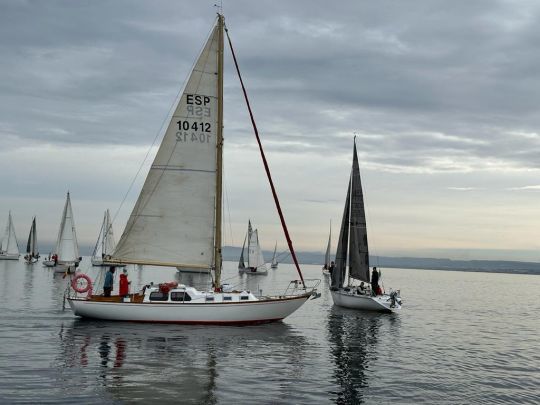
- Practical Boat Owner
- Digital edition

Norway to Scotland on a Nicholson 32 – a true North Sea passage
- June 18, 2020
Olly Wyatt sails from Norway to Scotland, but gale-force winds and on-passage incidents meant he got more experience than he bargained for...

In 34 knots of wind and a North Sea swell nearing mast height, our Nicholson 32 is beating with a momentum most modern cruisers lack. In a sense it isn’t surprising as we weigh in at seven-and-a-half tons. Crashing into a wave, a torrent of deck wash races towards us. Once again I take refuge under the weather hood to avoid a soaking.
Beyond the pitching transom white water trails every wave, but as far as I can see the horizon is free of ships.
Our heading isn’t quite our intended destination of Inverness: against the constant north-westerly we’ll need to tack northwards at some point. With leeway, I suspect our current track will take us somewhere between Newcastle and Hartlepool.
Two hundred miles astern is Norway. I recall our voyage so far…

It started with an email from Tris, who I’d met at an Ocean Yachtmaster course. He needed another crew to bring his Nicholson 32 Oosta back to Scotland after an extended Scandinavian cruise.
Alec, a fellow Nicholson 32 owner, was up for the expedition and Tris wondered whether I was too.
Before agreeing, I went fell running. From the summit the North Sea appeared bleak, and the pelting hailstones should have been a warning. It wouldn’t be plain sailing. On this voyage, I’d be expected to solo night-watch. I hadn’t even night-sailed before. I was keen, though, to experience the ocean first-hand and perhaps, if the distance was great enough, gain the practical element of my Yachtmaster Ocean qualification.
Landing at Stavanger Airport, the tarmac was whipped by a gusty headwind. Norway’s custom of doubling, sometimes tripling the prices we’d expect to pay back home came as something of a shock in the café. A four-hour bus ride took us to Kristiansand, where a quick supermarket dash saw us stocking up with the world’s most expensive cans of beer.
Re-epoxied bulkheads
Arriving at the shipyard gates and opening them by mobile phone, we spotted Oosta dwarfed by the gigantic cranes on the dockside. Tris had named her after Shetland’s most northerly rock, having grown up on the island of Unst where his RAF officer father had been posted to man the radar tracking station. The granite-grey hull was very much in keeping with Oosta ’s name, as was something else Tris hadn’t mentioned in the email: Oosta had just been repaired after hitting her keel on a Norwegian rock the previous year!
The saloon still reeked of epoxy, but it didn’t seem to deter the yard owner from joining us below deck.
Over one of our mortgage-worthy cans of beer he celebrated having just signed a contract with Volvo Penta. I was more concerned about sailing in a structurally-compromised boat, and began having flashbacks of some YouTube footage I’d seen. Filmed from a fishing boat, it showed a yacht sinking off North Utsire. However, the yard owner tried his best to reassure me that Oosta ’s re-epoxied bulkheads could take on the entire Atlantic, not just the North Sea.
We got to work restoring Oosta to her accustomed glory – unblocking sinks, refitting sails and jackstays, replacing bulbs, changing filters, removing gunk from the fuel tank and scrubbing the decks free of grime. When the temperamental Eberspächer heater finally woke up we celebrated with beers and chasers of Norway’s national spirit, Linie Aquavit.
The drinking, however, put added pressures on the toilet, which had begun to leak. Tris and Alec dismantled the entire unit and re-sealed the base where the shipyard had replaced a broken plinth. On departure day there was only one problem: the insurers hadn’t yet paid the shipyard, and Oosta wasn’t being released until they had. An exchange of emails and phone calls later, everything was thankfully sorted out.
Severe weather warnings

Sailing out of Kristiansand, we downloaded the latest meteorological data. Severe weather warnings had been issued for Forties, North Utsire and Viking, so Tris decided we’d seek shelter in Mandal. That night, while we were moored against the town’s quay, the North Sea was hammered by a Force 9, gusting 10. We would later experience gusts of Force 8, and that was quite enough. Tris’ decision was wise, and I was learning that frustrating choices are often required to make an offshore passage successful.
After breakfast, we found the bilges to be unusually high. Conversely, the water tank was unusually low. While heeling over the day before we must have lost a lot of water, as it was not a problem when level. We guessed the keel impact might have cracked the top of the GRP tank. Fixing it meant lifting the saloon floor. The 40-year-old screws weren’t budging, so more bottled water was purchased as a precaution.
Submerged rocks
Returning from the shops, we noticed a newly arrived British yacht beside ours. Bonaventure , owned by Paul and Liz Jackson, had just come across from Inverness, where we were headed. Invited aboard that evening, we enjoyed a taster of their extensive wine reserves – an essential provision for Scandinavian cruising. Bonaventure like Oosta , it turned out, also had experience of Norway’s many rocks. Over a drink or three, we learned of their previous year’s ordeal and how Norway’s lifeboats had charged them for their services. This made me extremely grateful to the RNLI and all the more keen to get Oosta into British waters.
Come the morning, we left Mandal and set a course for Scotland. The forecast – rough seas, but light-to-moderate south-westerly winds – turned out to be entirely inconsistent with the actual wind, in both direction and strength. It was accurate concerning the sea state, though: once clear of the harbour, harnesses were attached as Oosta was rolling 35° from horizontal. Alec was being sick over one side while I was trying not to fall over the other. Tris, meanwhile, was busy identifying submerged rocks, keen not to repeat Oosta ’s earlier indignity.
Engine failure

Harnessed in and wrapped up warm, the crew stick to a solo watch system of two hours on and four hours off
Motoring into the wind to clear the coastal outliers, the south-west corner of Norway became our lee-shore. This became a real danger when the engine cut out unexpectedly. We quickly unfurled the genoa. Putting Oosta into the wind to hoist the main, we were inadvertently tacked by the swell and found ourselves heading towards the lee shore.
Keeping our nerve, we built up boat speed, waited for some flatter waves and tacked Oosta back round. The focus now was beating as close to the wind as possible while still maintaining good speed and a heading to clear the headland of Lindesnes. We figured that the excessive rolling had stirred up the sludge in the fuel tank and this had choked the engine filters.
That was two days ago. Now, another night at sea is imminent. We’re doing two-hour solo watches, with four hours off. This system creates comradeship and binds you together as a crew. You entrust others when you’re asleep and you are solely responsible for them when it’s your watch.
Harnessed to the jackstays

Beyond the pitching transom, white water trails every wave…
Dawn is not quite here, and we’re still sailing close-hauled. I’m trimming the boat against the masthead wind indicator that’s lit up by the red and green navigation lights. The sea is mercurial, the sky starlit. The waves jolt the mast as I spot constellations in the darkness. The Plough I’m almost certain about, the others less so – there are just so many stars. A quick look through the saloon hatch at the AIS radar shows no other ships around. Above deck, the flare stacks from the Forties oil field peek above the horizon when they’re allowed to by the swell.
Dinner this evening is eventful. Plating up, we hear an almighty bang from on deck. Abandoning the spaghetti, we all fear we’ve hit something, but thankfully it’s only the shackle on the mainsail clew giving way. We replace it before dinner is allowed to get cold. This is nothing compared to the night before, though.
Finishing my watch and heading to the forepeak bunk, I noticed the hatch from the foredeck anchor locker had been swept off by a breaking wave. It was hanging on its lanyard over the stanchions and crashing against the hull. We put Oosta hove-to in more than 30 knots and big seas. Harnessed to the jackstays, Tris went to the bow and in the process of re-securing the hatch was soaked to the core, leaving him somewhat below par.
Morning has arrived. The sea is glistening. Gannets swoop around Oosta , entertaining us on the waves. The sun is out and so is Tris’ Soviet–era sextant in the hope that, prior to sighting land, we might be able to complete a sun-run-sun for the Yachtmaster Ocean practical assessment. I know however that we’re going to be quite a few miles short of the 600-mile passage the RYA requires. I’ve constructed alibis of being hit by extreme wind-shifts requiring us to put in two tacks of around 50 miles each, but Tris and Alec aren’t keen. Despite knowing the passage won’t qualify, we suffer the cranial pains of calculating a sun-run-sun astro-navigation fix which turns out to be uncannily accurate. I almost want the GPS to fail so that our efforts might be of some use.
Home waters
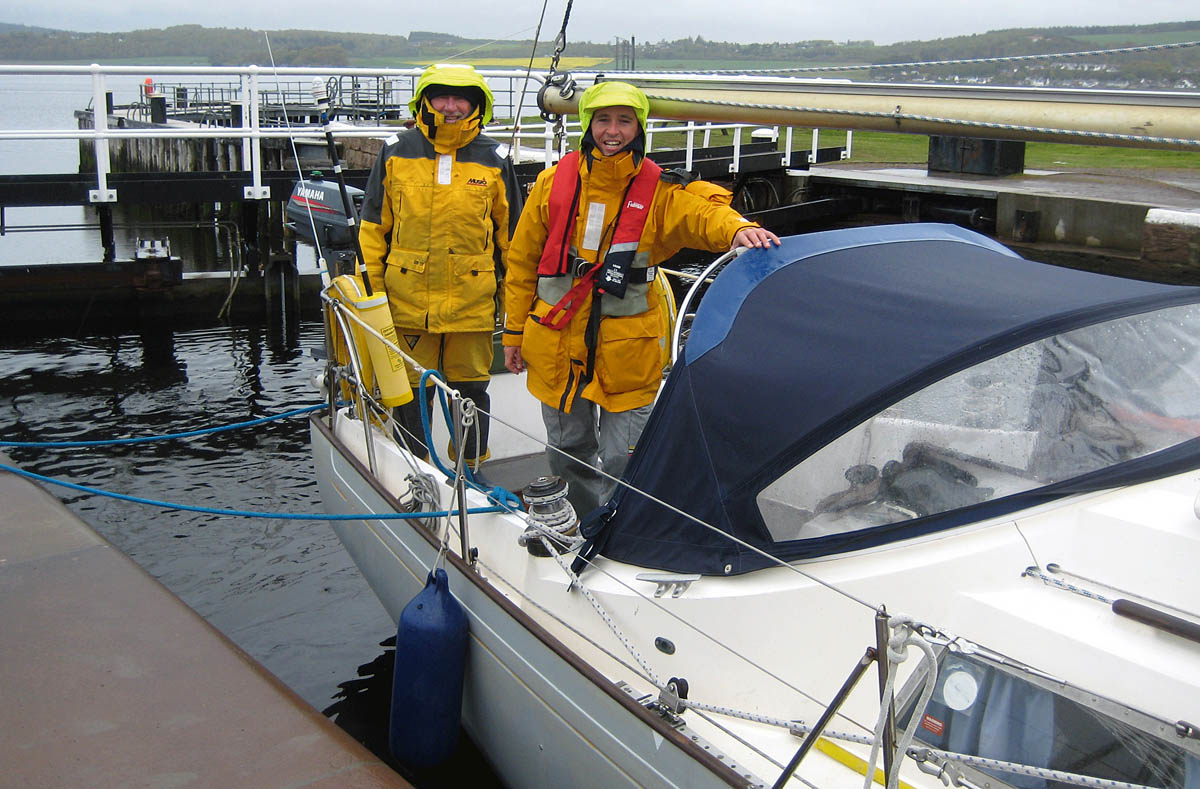
Olly and Alec aboard Oosta as she locks into the Caledonian Canal at Inverness
It’s the last day, and while I’ve been asleep Tris and Alec have navigated their home waters up the Moray Firth to Inverness and the Caledonian Canal. Into the sea lock, and two hours later we motor Oosta to her mooring. Yellow broom flowers reflect from the banks. Scotland is certainly greener than when we left, and as we’re reintroduced into civilisation I realise I’ve not showered for five days.
Tris’ wife Annie has brought us fresh coffee and pastries that we complement with the last of the Linie Aquavit. It is, after all, 11 in the morning, and although I didn’t gain my Ocean Practical we have all enjoyed a voyage that will stay with us for many years to come.

Olly Wyatt is the author of an oceangoing novel, The Democrat: www.thedemocratbook.com
Great choice! Your favorites are temporarily saved for this session. Sign in to save them permanently, access them on any device, and receive relevant alerts.
- Sailboat Guide
Nicholson 32
Nicholson 32 is a 31 ′ 11 ″ / 9.8 m monohull sailboat designed by Charles A. Nicholson and built by Halmatic Ltd. and Camper & Nicholson between 1962 and 1981.

Rig and Sails
Auxilary power, accomodations, calculations.
The theoretical maximum speed that a displacement hull can move efficiently through the water is determined by it's waterline length and displacement. It may be unable to reach this speed if the boat is underpowered or heavily loaded, though it may exceed this speed given enough power. Read more.
Classic hull speed formula:
Hull Speed = 1.34 x √LWL
Max Speed/Length ratio = 8.26 ÷ Displacement/Length ratio .311 Hull Speed = Max Speed/Length ratio x √LWL
Sail Area / Displacement Ratio
A measure of the power of the sails relative to the weight of the boat. The higher the number, the higher the performance, but the harder the boat will be to handle. This ratio is a "non-dimensional" value that facilitates comparisons between boats of different types and sizes. Read more.
SA/D = SA ÷ (D ÷ 64) 2/3
- SA : Sail area in square feet, derived by adding the mainsail area to 100% of the foretriangle area (the lateral area above the deck between the mast and the forestay).
- D : Displacement in pounds.
Ballast / Displacement Ratio
A measure of the stability of a boat's hull that suggests how well a monohull will stand up to its sails. The ballast displacement ratio indicates how much of the weight of a boat is placed for maximum stability against capsizing and is an indicator of stiffness and resistance to capsize.
Ballast / Displacement * 100
Displacement / Length Ratio
A measure of the weight of the boat relative to it's length at the waterline. The higher a boat’s D/L ratio, the more easily it will carry a load and the more comfortable its motion will be. The lower a boat's ratio is, the less power it takes to drive the boat to its nominal hull speed or beyond. Read more.
D/L = (D ÷ 2240) ÷ (0.01 x LWL)³
- D: Displacement of the boat in pounds.
- LWL: Waterline length in feet
Comfort Ratio
This ratio assess how quickly and abruptly a boat’s hull reacts to waves in a significant seaway, these being the elements of a boat’s motion most likely to cause seasickness. Read more.
Comfort ratio = D ÷ (.65 x (.7 LWL + .3 LOA) x Beam 1.33 )
- D: Displacement of the boat in pounds
- LOA: Length overall in feet
- Beam: Width of boat at the widest point in feet
Capsize Screening Formula
This formula attempts to indicate whether a given boat might be too wide and light to readily right itself after being overturned in extreme conditions. Read more.
CSV = Beam ÷ ³√(D / 64)
One of the most successful yachts built by Camper & Nicholson. Hulls were molded by Halmatic, at the time, sister company under the same corporate umbrella. A number of changes were made to the design during it’s nearly 20 year production run. Beginning around 1968, a number of boats were built under license by Rudder Yachts of Australia. Some of the later boats were sold directly from Halmatic.
Embed this page on your own website by copying and pasting this code.

Discover Related Sailboats

Halmatic Nicholson 32 MK X1
- About Sailboat Guide
©2024 Sea Time Tech, LLC
This site is protected by reCAPTCHA and the Google Privacy Policy and Terms of Service apply.
- Types of Sailboats
- Parts of a Sailboat
- Cruising Boats
- Small Sailboats
- Design Basics
- Sailboats under 30'
- Sailboats 30'-35
- Sailboats 35'-40'
- Sailboats 40'-45'
- Sailboats 45'-50'
- Sailboats 50'-55'
- Sailboats over 55'
- Masts & Spars
- Knots, Bends & Hitches
- The 12v Energy Equation
- Electronics & Instrumentation
- Build Your Own Boat
- Buying a Used Boat
- Choosing Accessories
- Living on a Boat
- Cruising Offshore
- Sailing in the Caribbean
- Anchoring Skills
- Sailing Authors & Their Writings
- Mary's Journal
- Nautical Terms
- Cruising Sailboats for Sale
- List your Boat for Sale Here!
- Used Sailing Equipment for Sale
- Sell Your Unwanted Gear
- Sailing eBooks: Download them here!
- Your Sailboats
- Your Sailing Stories
- Your Fishing Stories
- Advertising
- What's New?
- Chartering a Sailboat
- Cruising Yachts 30' to 35'
- Nicholson 32 Mk10
The Nicholson 32 Mk10 Sailboat Specs & Key Performance Indicators
The Nicholson 32 Mk 10, a heavy displacement long-keeled sloop, was designed by Charles Nicholson & Peter Nicholson and built in the UK by Halmatic Ltd.
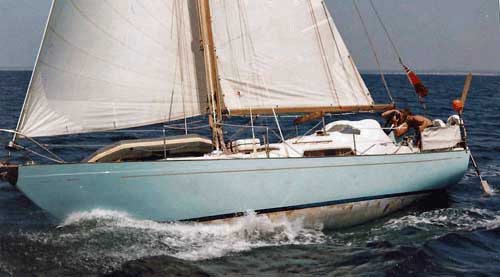
Published Specification for the Nicholson 32 Mk10
Underwater Profile: Long keel
Hull Material: GRP (Fibreglass)
Length Overall: 33'0" / 10.1m
Waterline Length: 24.0" / 7.3m
Beam: 9'3" / 2.8m
Draft: 5'6" / 1.7m
Rig Type: Masthead sloop
Displacement: 12,200lb / 5,534kg
Designer: Charles Nicholson & Peter Nicholson
Builder: Halmatic Ltd (UK)
Year First Built: 1978
Year Last Built: 1981
Number Built: ?
Owners Association: The Nicholson 32 Association
Published Design Ratios for the Nicholson 32 Mk10
1. Sail Area/Displacement Ratio: 16.7
2. Ballast/Displacement Ratio: 49.2
3. Displacement/Length Ratio: 441
4. Comfort Ratio: 40.
5. Capsize Screening Formula: 1.55
read more about these all-revealing numbers...
Summary Analysis of the Design Ratios for the Nicholson 32 Mk10
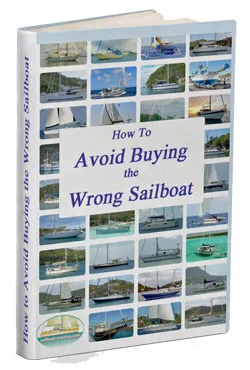
1. A Sail Area/Displacement Ratio of 16.7 suggests that the Nicholson 32 Mk 10 will, in the right conditions, approach her maximum hull speed readily and satisfy the sailing performance expectations of most cruising sailors.
2. A Ballast/Displacement Ratio of 49.2 means that the Nicholson 32 Mk 10 will stand up well to her canvas in a blow, helping her to power through the waves.
3. A Displacement/Length Ratio of 441, tells us the Nicholson 32 Mk 10 is firmly in the ultra-heavy displacement category. Load her up as much as you like and her performance will be hardly affected, not that it was ever startling. Few if any sailboats are built to this displacement category these days - but they remain popular with some long-distance sailors.
4. Ted Brewer's Comfort Ratio of 40.9 suggests that crew comfort of a Nicholson 32 Mk 10 in a seaway is similar to what you would associate with the motion of a heavy bluewater cruising boat. Pitching and rolling will be well damped - your cup of coffee on the salon table stands a reasonable chance of staying there in most conditions.
5. The Capsize Screening Formula (CSF) of 1.55 tells us that a Nicholson 32 Mk 10 would be a safer choice of sailboat for an ocean passage than one with a CSF of more than 2.0.
Cruisers' Questions...
How many Nicholson 32s were built and what are the main differences between the models?
According to the Nicholson 32 Association, 369 Nicholson 32s were built between 1963 and 1981. The boats went through 11 model upgrades, from Mk I to Mk XI, with various changes to the hull, deck, cockpit, rig, engine, interior and windows. Some of the most noticeable differences are the raised freeboard and lowered coachroof of the Mk X and XI models, the enlarged cockpit and centreline companionway of the Mk X models, and the different window shapes of the Mk I to VIII and Mk X and XI models.
What are the dimensions and specifications of the Nicholson 32?
The Nicholson 32 has a length overall of 9.75m (32ft) for the Mk I to IX models and 10m (33ft) for the Mk X and XI models. The beam is 2.82m (9ft 3in) and the draft is 1.68m (5ft 6in). The displacement is around 6.5 tonnes (14,330 lbs) and the ballast is around 3.2 tonnes (7,055 lbs). The sail area is around 46 sq m (495 sq ft).
How does the Nicholson 32 perform under sail and power?
The Nicholson 32 is a lovely boat to sail, with a sea-kindly motion, good stability and balance, and a moderate speed. It can handle rough weather well and has a good track record of ocean crossings. It is not very agile or fast in light winds or tight manoeuvres, but it can be improved with a larger genoa or a bowsprit. The original engine was a BMC 1.5 diesel with 35hp, which was adequate but noisy and smoky. Many owners have replaced it with more modern and reliable engines, such as Beta or Yanmar.
What are some of the advantages and disadvantages of owning a Nicholson 32?
Some of the advantages of owning a Nicholson 32 are:
- It is a beautiful boat with classic lines and a timeless appeal.
- It is well-built, strong and durable, with a high-quality finish.
- It is comfortable and spacious inside, with a traditional layout and plenty of storage.
- It is easy to handle and maintain, with simple systems and fittings.
- It is affordable and holds its value well, with a loyal following and an active association.
Some of the disadvantages of owning a Nicholson 32 are:
- It is prone to osmosis and may require peeling, drying and re-gelling.
- It has a low freeboard and may take water over the toe-rails or windows in heavy seas.
- It has a limited headroom of around 1.8m (5ft 11in) in the saloon and less in the forecabin.
- It has a small cockpit that can be wet and cramped for more than two people.
- It has a slow performance in light airs or upwind, especially with the original rig and engine.
What are some recommended upgrades for a Nicholson 32?
Some recommended upgrades for a Nicholson 32 may depend on the model and condition of the boat, but here are some general suggestions:
- Replacing the original engine with a more modern and reliable one, such as Beta or Yanmar. This can improve the performance, fuel efficiency, noise and emissions of the boat.
- Installing new winches or upgrading the existing ones to self-tailing or electric models. This can make handling the sails easier and safer, especially for short-handed sailing.
- Adding a bowsprit or a larger genoa to increase the sail area and improve the light wind performance. This can also balance the helm and reduce weather helm.
- Updating the electronics and navigation equipment, such as GPS, AIS, VHF, radar, autopilot, etc. This can enhance the safety, communication and convenience of the boat.
- Renewing the upholstery and cushions, or adding more insulation and ventilation to the interior. This can make the boat more comfortable and cosy, especially for long-term cruising.
The above answers were drafted by sailboat-cruising.com using GPT-4 (OpenAI’s large-scale language-generation model) as a research assistant to develop source material; we believe them to be accurate to the best of our knowledge.
Other sailboats in the Nicholson range include:
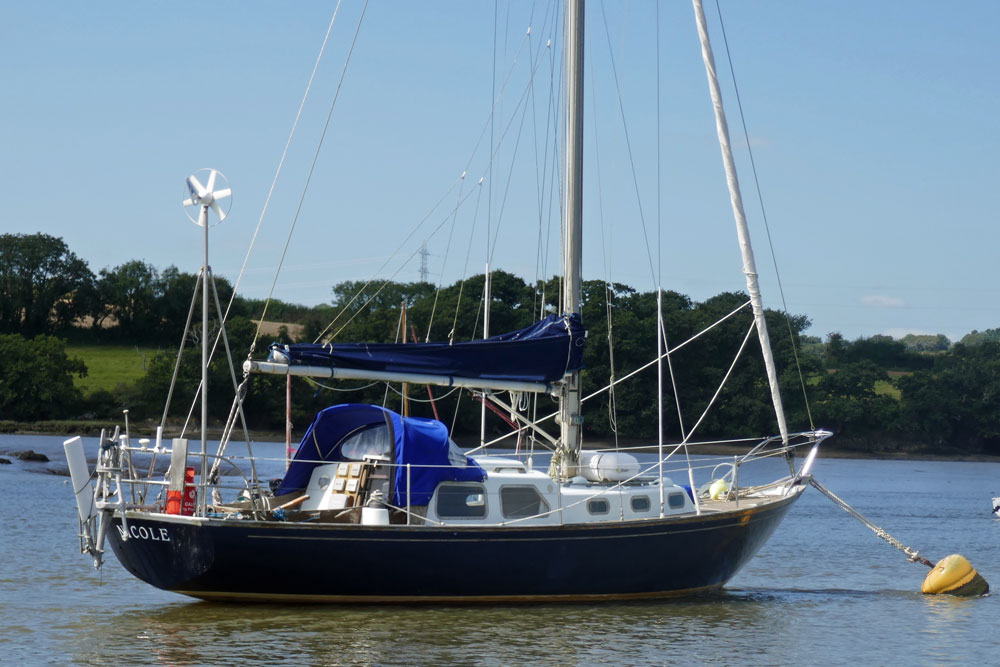
Recent Articles
'Natalya', a Jeanneau Sun Odyssey 54DS for Sale
Mar 17, 24 04:07 PM
'Wahoo', a Hunter Passage 42 for Sale
Mar 17, 24 08:13 AM
Used Sailing Equipment For Sale
Feb 28, 24 05:58 AM
Here's where to:
- Find Used Sailboats for Sale...
- Find Used Sailing Gear for Sale...
- List your Sailboat for Sale...
- List your Used Sailing Gear...
- Sign-up for our newsletter, 'The Sailboat Cruiser' ...
- Identify this month's Mystery Boat...
Our eBooks...

A few of our Most Popular Pages...

Copyright © 2024 Dick McClary Sailboat-Cruising.com
- Crewing Requests
- N32 Locations
- Logs, Blogs and Blarney
- Newsletters
- Press articles
- Trophy Record
- Merchandise
- Members Discounts
- My Nicholson
- Technical Articles
- Archived email forum
- Your account
- Application Form Recurring Associate Annual Membership
- Application Form Recurring Full Annual Membership
- Sell Your Yacht
- Technical topics
- Ownership topics
- Social topics
- Website topics
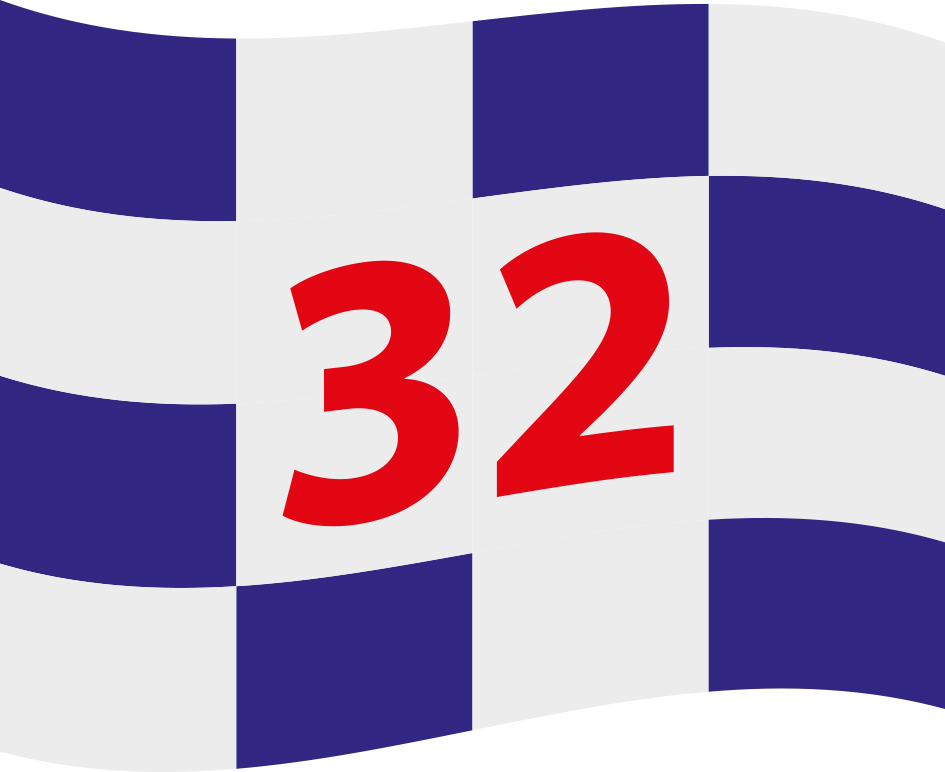
A GRP CLASSIC
The nicholson 32, a grp classic.
SPECIFICATION OF THE NICHOLSON 32
◦ LOA 33ft [10.05m] ◦ (note: Marks I to VIII were 32ft [9,70m]) ◦ L.W.L.: 24ft [7.31m] ◦ Beam: 9ft 3in [2.80m] ◦ Draught: 5ft 6in [1.60m] ◦ Displacement: 6.1ton [6,211kg] ◦ Ballast(keel): 3.0ton [3,100kg] ◦ Sail area: 594ft² [55m² ] ◦ Fuel: 16gal [72lit] ◦ Water: 45gal [204lit]
Designed by: Peter and Charles A. Nicholson 1962/63
Built by: Moulders: Halmatic Ltd., Havant, Hampshire, P09 lJR. Marks I to III finished by Field Aircraft Services, Wymeswold and Camper and Nicholson, Gosport. Marks IV to XI finished by Halmatic and Camper and Nicholson. Marks I to VIII marketed by Camper and Nicholson. Marks X and XI marketed by Halmatic.
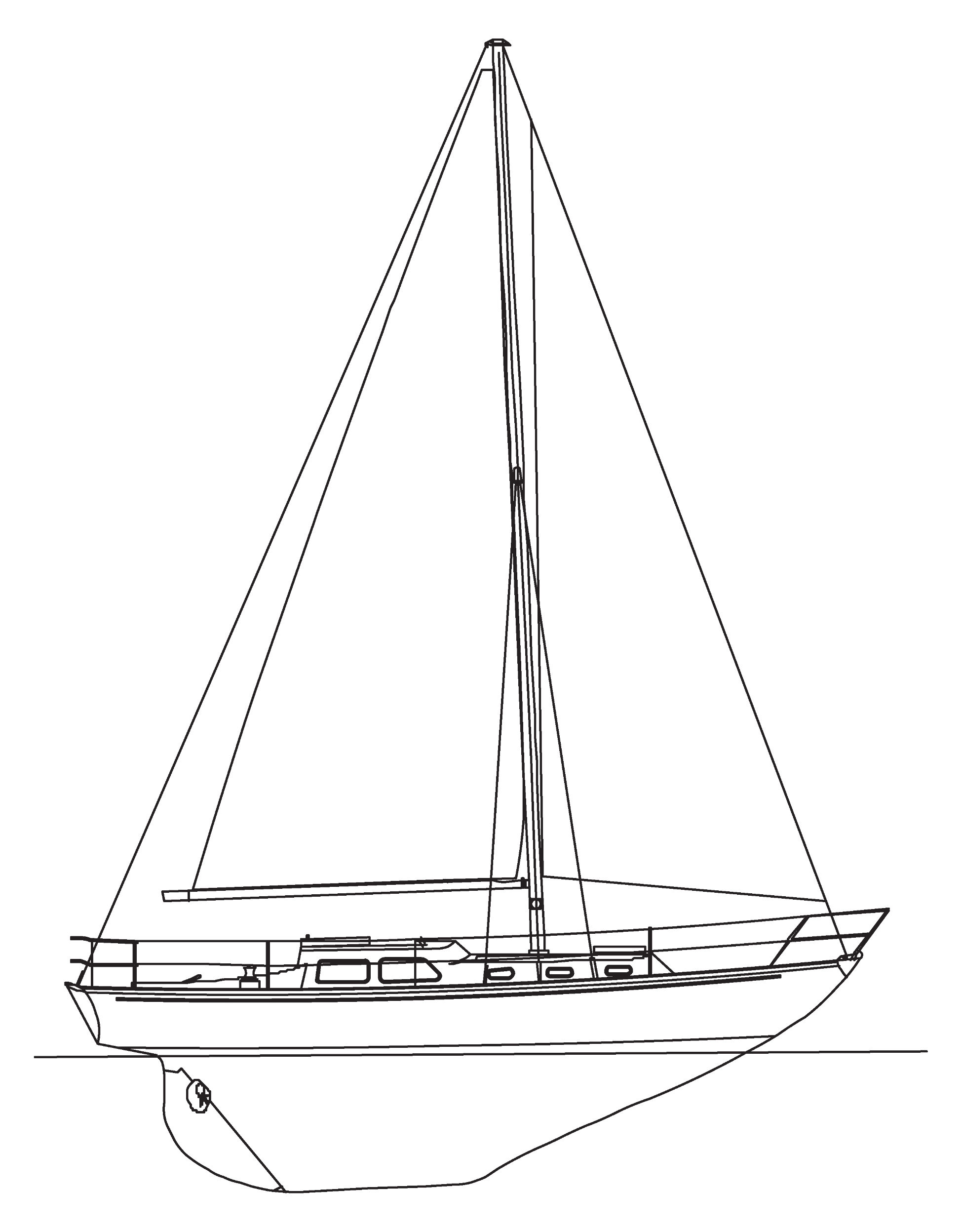
Boatshed Plymouth
- Watch in My Boatshed
- Print Print spec sheet Print Boat Photos
- Specification
- Additional Information
Extra Details
Sloop rigged Sparlight Aluminium spars (1972) with Stainless Steel standing rigging (2016)
Mast epoxy pack painted 2016. New head sail Furlex system installed 2017. Other sails may need altering to fit the Furlex system.
Electrical Systems
12 volt battery, 240 shore power voltage, 2 batteries charged by: engine, shore power
Construction
2 white plastic water containers 10 litre each Autohelm. Hull finished in Gelcoat with paint.
Accommodation
Lavac toilet. 2 boarding ladders, one folding. Beaching legs.
2 burner propane Stove
2 halyard winches 2 sheet winches Electric windlass (with remote control) 2 anchors (CQR 15.9 kg & Danforth 12.7kg) 55.00m of chain SP3 Hasler Vane Gear windvane self-steering system Seago dinghy () (Inflatable) New spray hood.
Nav Equipment
Raymarine ST2000 has an intermittent fault which the owner believes is simply a loose connection. The navigation lights will also need to be checked for the front red/port light and white stern light.
Safety Equipment
2 bilge pumps (2 manual / 0 electric)
4 person Liferaft in valise 2006 last serviced 2012
Broker's Comments
Nice example of the ever popular Nicholson 32.
A great cruiser that is capable in taking you anywhere in comfort with plenty of space for overnight stays.
The Nicholson 32 has proved an amazing success with nearly 400 built.
Her weight and easy sections give her a motion with no shocks or surprises allowing crew to move about with ease.
This boat appears in good condition for her age.
She is currently undergoing the fitting of some new stanchion bases on her port side and the owner has also informed me that on the 12th August 2023 he completed a new application of antifoul paint to her hull.
Please don't hesitate to contact me for a viewing!
These boat details are subject to contract. Note: Offers on the asking price may be considered.
Owners FAQ's
How long have you owned the boat for.
Nine and a half years.
Why are you selling her?
Changing over to a power boat.
Where have you sailed her?
Scotland and the Solent.
Please note this comments section is public . Please do not post your personal details here. To enquire about purchasing this boat, please contact the broker directly at [email protected] Please read our commenting guidelines before posting.
Get Access to More
View unlimited photos of every boat
Walkthrough videos
VR 720° experiences
Get notified of new boats of your interest
Personalised boat recommendations
Save boats to 'My Boatshed'
Jason Currie-Smith
Cost of ownership.

IMAGES
VIDEO
COMMENTS
The Nicholson 32 was a development of the successful South Coast One Design (SCOD) and other proven Charles Nicholson designs like the nine-tonner, Jolina. Charles' son, Peter, believed demand for custom yachts was dwindling and glass-fibre production yachts were the future. The Nicholson 32 had to meet three criteria.
1965 Nicholson 32 MK IV. US$27,962. ↓ Price Drop. boatpoint | Blyth, Northumberland. <. >. * Price displayed is based on today's currency conversion rate of the listed sales price. Boats Group does not guarantee the accuracy of conversion rates and rates may differ than those provided by financial institutions at the time of transaction.
NICHOLSON 32. Save to Favorites . Beta Marine. BOTH. US IMPERIAL. METRIC. Sailboat Specifications Definitions ... 1997), states that a boat with a BN of less than 1.3 will be slow in light winds. A boat with a BN of 1.6 or greater is a boat that will be reefed often in offshore cruising. Derek Harvey, "Multihulls for Cruising and Racing ...
The Nicholson 32 was one of the first production-built GRP yachts of its size. It quickly gained a reputation for being an ultimate go-anywhere cruiser that was also fitted out to a high standard. Some 370 were built over an 18-year period, following the launch of the prototype in 1963, and examples have ventured to all parts of the globe.
The Nicholson 32 was designed in 1961/62 by Peter Nicholson. The hull was moulded and tooled by Halmatic Ltd and marketed by Camper & Nicholsons. The first boat Forerunner was commissioned in 1963 and priced at £4,900. Between 1963 and 1971 various modifications were made and described as MkI to MkVII. In 1972 the MkX was introduced with a ...
The Nicholson 32 heralded the advent of series boat production in glassfibre and began a revolution in building techniques, most of which are common practice today. ... The 32 was a development of boats like the highly successful South Coast One-Design and other proven winners designed by Charles Nicholson, such as the 9-tonner Jolina and the ...
Construction: This Nicholson 32 MKIV, designed by Camper & Nicholson and built by Halmatic in Portsmouth in 1965. The hull topsides have been painted to a very high standard and finished in smart blue coveline stripes. Well laid out cockpit with recently painted locker interiors and newly installed locker lids.
Nicholson 32: a 9.75m sailboat capable of circumnavigating the globe. Benoit is the 5th owner of a Nicholson 32, a long-keel sloop with an excellent reputation. He tells us why he chose this yacht, as well as his first impressions. Maxime Leriche Published on December 15, 2023.
Find Nicholson 32 sail for sale on YachtWorld Europe's largest marketplace for boats & yachts. We connect over 10 million boat buyers and sellers each year! ... 1965 Nicholson 32 MK IV. US$31,195* US $300/mo. Blyth, Northumberland. 32ft - 1965. Offered By: boatpoint. Contact < 1 > * Price displayed is based on today's currency conversion rate ...
Olly Wyatt sails from Norway to Scotland, but gale-force winds and on-passage incidents meant he got more experience than he bargained for... In 34 knots of wind and a North Sea swell nearing mast height, our Nicholson 32 is beating with a momentum most modern cruisers lack. In a sense it isn't surprising as we weigh in at seven-and-a-half tons.
Nicholson 32 yachts for sale. On this page you can find details of Association members' Nicholson 32 yachts currently for sale. If you are selling your Nic 32 and would like to show details please complete and submit the form on the Sell Your Yacht page in the Members' area. This service is only available to members of the Nicholson 32 ...
The Nicholson 32 is considered by many to be the benchmark classic long keel yacht for serious offshore and bluewater cruising in their class, the most desirable being these later Mk X and XI versions, offering increased headroom and space below decks together with numerous other design improvements.
Nicholson 32 is a 31′ 11″ / 9.8 m monohull sailboat designed by Charles A. Nicholson and built by Halmatic Ltd. and Camper & Nicholson between 1962 and 1981. ... It may be unable to reach this speed if the boat is underpowered or heavily loaded, though it may exceed this speed given enough power. Read more.
The Nicholson 32 is a lovely boat to sail, with a sea-kindly motion, good stability and balance, and a moderate speed. It can handle rough weather well and has a good track record of ocean crossings. It is not very agile or fast in light winds or tight manoeuvres, but it can be improved with a larger genoa or a bowsprit. ...
Find Nicholson boats for sale in your area & across the world on YachtWorld. Offering the best selection of Nicholson boats to choose from. ... 32, 32 MK IV, 32 Mk V and 345. Nicholson models are available through yacht brokers, dealers, and brokerages on YachtWorld. The listings encompass a range of years, starting from 1966 models up to 1998.
Offering the best selection of Nicholson boats to choose from. ... Nicholson ⁄ / 32; Nicholson 32 boats for sale. Clear Filter Make / Model: Nicholson - 32. Location. By Radius. By Country. country-all. All Countries. Country-GB. United Kingdom. All. Alle 25 km 50 km 100 km 200 km 300 km 500 km 1000 km 2000 km 5000 km.
Beautiful Nicholson 32 This yacht is the MKVII version of the Nicholson 32 range. Built by Camper and Nicholson in 1969 The current owned has owned and cared for "Mist of Morven" for the past 47 years. She is wintered ashore undercover in a shed in a traditional Boatyard.
S# first appeared (that we know of) in TellTales, April 1988, "On a Scale of One to Ten" by A.P. Brooks . The equation incorporates SA/Disp (100% fore triangle) and Disp/length ratios to create a guide to probable boat performance vs. other boats of comparable size. For boats of the same length, generally the higher the S#, the lower the PHRF.
Nicholson 32 Mk V - 1966. This beautiful Nicholson 32 Mk V has undergone a recent extensive refurbish, which includes new standing rigging and a refreshed interior. She really is a prime example of a Mk V and isn't expected to be available for long! Fin Keel, Beta BD722 Inboard Engine (2000), Standing Rigging replaced 2015, Running rigging ...
Nicholson 32 boats for sale 4 Boats Available. Currency $ - USD - US Dollar Sort Sort Order List View Gallery View Submit. Advertisement. Save This Boat. Nicholson 32 . Cardiff, Cardiff (Caerdydd), United Kingdom. 1974. $18,471 Seller BJ Marine (Cardiff) 29. Contact +44 (0)7815 561554. ×. Save This Boat. Nicholson 32 Mk V ...
Sell Your Yacht; Nic 32 Owners Forum. Technical topics; Ownership topics; Social topics; Website topics; 0 Items. The Nicholson 32. N32 History; N32 Specification; N32 - The Classics; ... THE NICHOLSON 32 A GRP Classic. SPECIFICATION OF THE NICHOLSON 32 LOA 33ft [10.05m] (note: Marks I to VIII were 32ft [9,70m]) L.W.L.: 24ft [7.31m]
Nicholson 32 MkX - 'Cavatine' The Nicholson 32 is a capable and well-built cruising yacht, a tried-and-tested classic. @Cavatine' is a well-equipped example, in commission and ready for her next adventure.
The Nicholson 32 has proved an amazing success with nearly 400 built. ... At all times, where the particulars herein give details of a new boat and/or a new boat to be supplied/built by a builder/manufacturer, or a boat to be chartered, via our introduction, we do not guarantee or assume responsibility for the accuracy or reliability of any ...